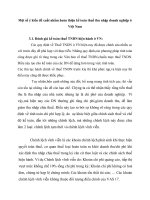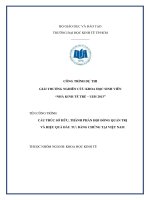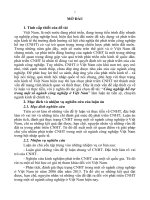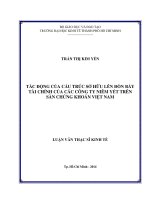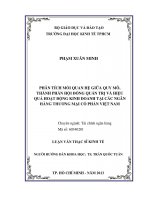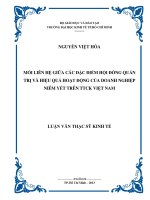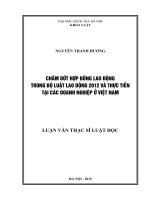Cấu trúc sở hữu, đặc tính hội đồng quản trị và hiệu quả hoạt động doanh nghiệp ở việt nam (tóm tắt)
Bạn đang xem bản rút gọn của tài liệu. Xem và tải ngay bản đầy đủ của tài liệu tại đây (126.5 KB, 28 trang )
VIETNAM NATIONAL UNIVERSITY OF HO CHI MINH CITY
UNIVERSITY OF TECHNOLOGY
NGUYỄN TIẾN THÔNG
OWNERSHIP STRUCTURE, BOARD CHARACTERISTICS AND FIRM
PERFORMANCE IN VIETNAM
Subject: Business Administration
Code: 62340501
PhD THESIS SUMMARY
HO CHI MINH CITY, 2017
1
The Thesis was completed in University of Te chnology –VNU-HCM
Advisor 1: PhD. Nguyễn Thu Hiền
Advisor 2: Assoc Prof.PhD. Piman Limpaphayom
Independent examiner 1: Assoc Prof.PhD. Vương Đức Hoàng Quân
Independent examiner 2: Assoc Prof.PhD. Đỗ Bá Khang
Examiner 1: Assoc Prof.PhD. Võ Thị Quý
Examiner 2: Assoc Prof.PhD. Nguyễn Minh Hà
Examiner 3: Assoc Prof.PhD. Nguyễn Minh Kiều
The thesis will be defended before thesis committee at
...................................................................................................................................
...................................................................................................................................
on
The thesis information can be looked at following libraries:
- General Science Library Tp. HCM
- Library of University of Technology – VNU-HCM
2
LIST OF PUBLICATIONS
1. Nguyen, T. T. (2014). Factors influencing Voluntary Disclosure of
Vietnamese listed companies. EBES, Singapore, ISBN: 987-605-64002-7-8
2. Nguyen, T. T. (2015). Internal Governance Mechanisms and Firm
Performance: The Case of Vietnam. ICBMLS, Singapore, ISSN 2454-5899
3. Nguyen, T. T. (2015). Internal Governance Mechanisms and Firm
Performance: The Case of Vietnam. PEOPLE: International Journal of Social
Sciences, Special Issue, 254-269.
4. Nguyen, T. D., Nguyen, H. T. and Nguyen, T. T. (2013). Role of Dividend
Policy to Shareholders Value and Risk in Condition of Disclosure &
Transparency. IFMA, Indonesia, ISBN: 987-602-14716-0-9.
5. Nguyen, H. T., Tran, T. D., Nguyen, H. N. H., Vo, N. T.T. and Nguyen, T. T.
(2016). Quản Trị Công Ty và Quá Trình Điều Chỉnh Động Cấu Trúc Vốn –
Quan Sát Từ Các Doanh Nghiệp Niêm Yết Trên Thị Trường Chứng Khoán Việt
Nam. Tạp Chí Khoa Học Đại học Mở TP.HCM, 50 (5), 25-40.
ABSTRACT
In recent years, corporate governance research received increasing attention
because of scandals involving manipulation of corporate power and even
alleged criminal activities. Good corporate governance would contribute to the
sustainable development of the economy through the promotion of enterprise
capacity and increasing access to capital from outside the enterprise. Better
corporate governance could lead to better corporate performance and impede
expropriation of controlling shareholders from minority shareholders.
Vietnam’s Government recently implies the important role of State Capital
Investment Corporation in equitization. However, the role of State-Owned
Holding Company (SOHC) is not taken into consideration in recent global
corporate governance studies, especially in weak regulatory environment like
Vietnam. Applying quantitative method on panel data of listed companies in
Vietnam during 2009-2013, this study found that SOHCs have positive impacts
on firm performance which is a contribution to both theory and practice in
corporate governance research. Furthermore, there was no study related to the
role of Board Ownership Deviation over the world and this kind of ownership is
found to have positive impact on firm performance in Vietnam. This finding
3
consolidates the principal-principal agency theory as well as contributes a new
understanding about Board members’ relationships. This study, further, found
the relationships between State Ownership, Institutional Ownership,
Institutional Ownership Deviation, Foreign Ownership, Independent Directors,
Non-executive Directors and firm performance which is an effective reference
to policy makers, investors and relevant stakeholders to figure an enthusiastic
corporate governance for Vietnam.
4
CHAPTER 1 INTRODUCTION
1.1
Overview
In general, models of corporate governance are diverse across countries. These
differs are related to the diversity of capitalism in which corporate governance
are embedded. The Anglo-Saxon countries (US and U.K) emphasize the
interests of shareholders while the coordinated or multi-stakeholder model
associated with Continental Europe (Germany and France) and Japan
recognizes the interests of workers, managers, suppliers, customers, and the
community (Allen and Gale, 2002). The corporate governance model of the
Anglo-Saxon countries represents the “outsider” system and the model of the
Continental Europe, on the other hand, is called “insider” system (Tan and
Wang, 2007).
The Anglo-Saxon corporate governance model has characterized with the
principal–agent issues from the separation of ownership and control in highly
dispersed ownership structure. To mitigate the conflict of interest associated
with the principal–agent problem, appropriate governance structures must be
effectively embedded. These includes robust external mechanisms (Hu et al.,
2009). Continental Europe, on the other hand, is facing with controllingminority shareholders’ issues. Emerging markets, especially Asian countries,
have the same concentrated ownership structure like Continental Europe model.
These markets are characterized with a weak legal protection to shareholders
and therefore, different corporate governance mechanism approach is required.
In this circumstance, internal governance mechanisms (IGMs) are expected to
play a more prevalent role in these countries in addressing the principal–
principal problem (Hu et al., 2009).
Better corporate governance could lead to better corporate performance and
expropriation of controlling shareholders is supposed to be prevented.
Moreover, better decision-making proceess is expected in these companies
(Nam and Nam, 2004). Good corporate governance increases the market
5
valuation of companies by improving their financial performance, reducing the
risk that boards would make self-serving decisions, and generally raising
investor confidence (Newell and Wilson, 2002).
The rise of sovereign wealth funds (SWFs) and state-owned holding companies
(SOHCs) and the dominance of state-owned enterprises (SOEs) in some
countries has recently raised concerns related to their governance structures, the
transparency of their investment (Chen, 2013). Several studies have been
conducted to examine the roles of government-linked companies (GLCs)
including Ang and Ding (2006), Wicaksono (2009) and Chen (2013). GLCs are
companies that partially owned by the government and proportion of ownership
of the government in these firms varies from very low to very high levels.
SOEs & GLCs have a dominant role in Vietnam’s economy. SOEs, besides, are
claimed with lacking of transparency (Kamal, 2010). In 2005, State Capital
Investment Corporation (SCIC) was established in Vietnam as a state-owned
holding company (SHOC). SCIC represent the state capital interests in
enterprises and invest in key sectors and essential industries and to become a
strategic investor of the government that is responsible for generating
maximum generating maximum value and sustainable returns on investments.
Hochiminh-City Fianance and Investment State-Owned Company (HFIC) was
created in 1996 with a purpose to develop a focus and effective mechanism to
mobilize capital for Ho Chi Minh City. SCIC/HFIC model is expected to follow
similar model of Temasek in Singapore which is ascertained as efficiency but
its role in Vietnam is not demonstrated.
Moreover, there was no empirical research to investigate the role of board
ownership deviation in which impact of largest shareholder is excluded.
1.2
Research Gaps
Vietnam is considered as a poor corporate governance standards and there has
not been much work published on Vietnamese corporate governance. Moreover,
state ownership is not a major interest of study in all previous researches in
6
Vietnam. Especially, there is lacking of studies on the roles of ownership
structure and board characteristics with a focus on different type of state
ownership on firm performance. Moreover, previous studies examined the
relationship between internal corporate governance aspects on single factors of
IGMs without consideration the relationship between board characteristics and
ownership structure (Denis & Sarin, 1999; Mak & Li, 2001; Desender, 2009).
To fill this gap, this study takes into account jointly IGMs in one model to
examine for simultaneously effects of board characteristics and ownership
strucutre on firm performance in Vietnamese market.
The lack of corporate governance analysis for Vietnamese SOEs and GLCs is
the second gap that need to be fulfilled. The difficulty in determining the
principal at SOEs impedes the development of an appropriate mechanism for
aligning the agent’s interest with the principal’s as explanation of agency theory
(Wicaksono, 2009). SOE corporate governance are facing with three main
challenges including multiple and conflicting objectives, excessive political
interference and opacity (Wong, 2004; Wicaksono, 2009). SOEs and GLCs is
regulated to have dominant roles in Vietnamese economy but there has not been
an inclusive study being conducted to assess their efficiency in comparison with
private sector’s enterprises in Vietnam.
SOHC is a new model and its role is not demonstrated in many countries.
Especially for emerging countries with weak regulatory environment, there has
not been empirical study on SOHC influence. SOHC is a model in which
government does not directly manage the enterprises as traditionally model as
as the holding structure is also believed to be able to serve as a layer shielding
the SOEs from politics and government intervention while transparency can be
best improved by opening access of ownership to the public (Wicaksono,
2009). Vietnam is a developing country with strong orientation from
government in comparison to developed market orientation. SCIC and HFIC
are SOHCs in Vietnam. The equitization is is accelerated in recent years and the
requirement to transfer state ownership to SCIC require a detailed study of the
7
effectiveness of the SOHC model. The effectiveness of SOHC model in
Vietnam is not demonstrated and it is a research gap.
A new area that has not been explored in literature by the knowledge of the
author is the bargaining power in the boardroom that may be rooted in deviation
of roles among board members due to the influence of some dominant
members/groups of members, such as a major shareholder, in board discussion
and board resolution. The deviation of ownership among board members, or the
difference of ownership between the major shareholder’s representative and the
other shareholders, could be an important factor that hinder the board
effectiveness. This argument originates from the agency theory (Jensen and
Meckling, 1976). Originally, the agency theory explained the conflicts between
shareholders and managers. Recently, agency theory is developed in global
researches and explained for conflicts between controlling shareholders and
minority shareholders. These relationships provide a glimpse on interest
conflicts between directors as in Young et al. (2008) and Earle et al. (2005).
Young et al. (2008) argued that board ownership is examined as a unified entity
ignoring there would be potential conflicts of interest between shareholder
groups and there could be the conflict of interests between these blockholders
(Earle et al., 2005). These blockholders decide the board of directors and their
potential conflicts could impact on firm performance in which the largest
shareholder is the most powerful group and other directors form a
counterweight. Board ownership deviation, or the deviation of ownership
among board members, which is measured by the ownership of board of
directors excluding largest ownership, is to reflect the power deviation among
board members/groups of board members is not demonstrated in both
theoretical and empirical studies. The findings of board ownership deviation
impacts are expected to be a new contribution to corporate governance
literature. This study therefore also aims at filling this gap.
8
CHAPTER 2 LITERATURE REVIEW
2.1
Agency Theory
Agency theory models the relationship between the principal and the agent.
Jensen and Meckling (1976) defined an agency relationship as “a contract under
which one or more persons (the principal(s)) engage another person (the agent)
to perform some service on their behalf which involves delegating some
decision making authority to the agent”. In the context of the firm, the agent
(manager) acts on behalf of the principal (shareholder) (Eisenhardt, 1989;
Jensen and Meckling, 1976).
The principal has to use agent because he does not have enough ability to
maximize value of his own property. The owner also use agent when he has
resources restrictions. As part of this, the principal will delegate some decisionmaking authority to the agent and the welfare of the principal is affected by the
choices of the agent. Therefore, the major issue is the information asymmetry
between managers (agents) and shareholders (owners). In this relationship,
insiders (managers) have an information advantage. The agent may take
unobservability activities to enhance his personal goals (Eisenhardt, 1989;
Jensen and Meckling, 1976).
2.2
Corporate Governance
Corporate governance is a term that refers broadly to the rules, processes, or
laws by which businesses are operated, regulated, and controlled (Obi, 2009,
cited Kasum and Etudaiye-Muhtar, 2014). The term can refer to internal factors
defined by the officers, stockholders or constitution of a corporation, as well as
to external forces such as consumer groups, clients, and government regulations
(Idowu et al., 2015). Corporate governance is often viewed as both the structure
and the relationships which define corporate direction and performance. The
board of directors is naturally central to corporate governance. Its relationship
to shareholders and management is critical. Other participants include
9
employees, customers, suppliers, and creditors. Corporate governance is also a
mechanism to reduce or eliminate agency problem (Singh, 2012).
2.3
State-Owned Holding Company
Wong (2004) stated that problems of SOEs governance are multiple conflicting
objectives, political intervention and lack of transparency. The holding structure
seems to well serve the purpose of resolving the first two problems at SOEs as
the holding structure is also believed to be able to serve as a layer shielding the
SOEs from politics and government intervention while transparency can be
improved by opening access of ownership to the public (Wicaksono, 2009).
Placing SOEs under the control of an SOHC rather than the direct ownership of
the state might reduce the conflict inherent in the state’s roles as both
shareholder and regulator (Chen, 2013). SOHC acts as a safety valve between a
regulator and a regulated firm (Hamdani and Kamar, 2012). This would allow
the government the flexibility to deal with a particular target firm or industry,
and may help avoid a dilemma in which a heavy regulatory enforcement action
harms the government’s interests as a shareholder (Chen, 2013).
2.4
Board Ownership Deviation
Board Ownership is main area of ownership structure studies. The convergence
of interest hypothesis believes managerial ownership has positive effect while
managerial entrenchment hypothesis has opposed view (Jensen and Meckling,
1976; Hu and Izumida, 2008). Board ownership is examined as a unified entity
ignoring there could be potential conflicts of interest between shareholder
groups Young et al. (2008) and there could be the conflict of interests between
these blockholders (Earle et al., 2005).
Ownership deviation in this study is defined as the opposed ownership of board
members other than largest shareholder. Basing on the assumption of conflicts
between blockholders and the dominant role of largest shareholder, the
10
ownership of members other than largest shareholder could act as constricted
entity to the role of largest shareholder.
Board members are presentative for different shareholders or group of
shareholders as board composition are strongly correlated with ownership
structure (Li, 1994). Earle et al. (2005) argued that if there is a dominant
shareholder presented in a firm, the monitoring contribution of other small
blockholders is no vital. However, if ownership of other members is large
enough, it could resist the dominance of largest shareholder. Therefore, the
board ownership deviation could have positive role in ownership structure.
2.5
Institutional Ownership Deviation
Many studies have found that state ownership does not produce superior firm
performance, but it is often linked to low efficiency (Hu et al., 2009.
SOEs, on the other hand, are also institutional investors in stock exchanges.
Institutional investors are found to have positive effects on firm performance as
well as enhance corporate governance in many studies (Balatbat et al., 2004;
Chen et al., 2008). The ownership of state could outweigh the benefit of other
institutional investors. Therefore, exploring the role of non-state institutional
investors could provide a clear understanding about the role of intuitional
investors.
2.6
Impacts of IGMs on Firm Performance
Since 1990s, conflicts between controlling shareholders and minority
shareholders have been emerged in academic researches. Interests of large
shareholders could be diverged from minority shareholders’ benefits (Hu and
Izumida, 2008). Controlling shareholders could exploit the interests of minority
shareholders via related party transactions as well as falsifications of financial
statements (Hu et al., 2008).
Hypothesis 1: Ownership of the largest shareholder has a negative impact on
firm performance.
11
There is a problem of inefficient performance of SOEs. Many studies have
found that state ownership is often linked to low efficiency (Bai et al., 2004;
Ding et al., 2007).
Vietnam has SCIC and HFIC which are SOHCs. These companies participate
into SOEs equitization to enhance efficiency of state capital utilization. SOHC
is more likely to act as an active investor and push for more transparency and
better corporate governance to earn long-term profits (Chen, 2013) and
companies related to SOHC are found to have higher quality of corporate
governance (Chen, 2013).
Hypothesis 2: State ownership has a negative impact on firm performance.
Hypothesis 2a: SOHC ownership has a positive impact on firm performance.
Family ownership concentration could increase the expropriation of non-family
minority shareholders (Bloom and Van Reenen, 2006). In family companies,
unqualified members could be appointed to key positions without competition
(Claessens et al., 2000). Moreover, because of close relations and informal
linkages, family managers are less to be monitored (Young et al, 2008).
Hypothesis 3: Family ownership has a negative impact on firm performance.
Fama and Jensen (1983), in managerial entrenchment hypothesis, argued that
managers with a significant equity to protect his position from outside control
would not contribute best effort and could decrease the firm performance.
Managers with insignificant ownership would be afraid of disciplines from
market controls hence would act on behalf of shareholders’ value.
Supervisory board, as regulating in laws, acts as monitor mechanism to protect
benefits for all shareholders. Supervisors are expected to be active and effective
in monitoring activities of BOD & Managers.
Besides, Earle et al. (2005) argued that there could be the conflict of interests
between blockholders. The ownership of other members other than largest
shareholder could converge their interests with minority shareholders and they
12
could act as effective monitoring mechanism as Jensen and Meckling (1976)
argued that a sufficient high level of managerial ownership aligns the interests
of managers and shareholders hence improve the firm performance.
Hypothesis 4: Ownership of Board of Directors has negative impact on firm
performance.
Hypothesis 4a: Ownership of Supervisory Board has positive impact on firm
performance.
Hypothesis 4b: Ownership of directors other than largest ownership has
positive impact on firm performance
Large shareholders likely play a crucial role in monitoring and controlling.
Chen et al. (2008) argued that there are three benefits with institutional
ownership including they are correlated with the higher proportion of the
economic profit due to cost effectiveness, cost reduction in coordinating the
management, and big institutions would find more difficulties and more
expensiveness when it try to sell its big quantity of shares.
SOEs, however, are also institutional investors. SOEs are linked to low
efficiency (Bai et al., 2004; Ding et al., 2007). The ownership of state could
outweigh the benefit of other institutional investors. If ownership of other
instructional investors are sufficient enough, the impact on firm performance
could be positive.
Hypothesis 5: Institutional Ownership has a positive impact on firm
performance.
Hypothesis 5a: Ownership of non-state institutions has a positive impact on
firm performance.
Pfaffermayr and Bellak (2000) argue that affiliating with foreign firms help
local companies have access to newer and superior technologies and lead to
superior performance.
13
Hypothesis 6: Foreign Ownership has a positive impact on firm performance
Although BOD acts as monitor mechanism to protect benefits for all
shareholders including minority shareholders, the negative effects of having
controlling directors could outweigh the benefits of their presence. First,
controlling directors actively influence on the strategy and objectives of
company in line with their interest not minority shareholders’ (Claessens et al.,
2000; Young et al., 2008). Second, the presence of controlling directors could
potentially weaken the governance role of other directors, making the board
less effective (Hu et al., 2009).
Hypothesis 7: The proportion of directors related to largest shareholder on the
BOD has a negative impact on firm performance.
One of the vital roles of BOD is independence. The independence is to provide
defense against the exploitative behavior by the controlling shareholders and
other directors. Independent director is a mechanism to enhance the
independence of BOD (Hu et al., 2009).
Hypothesis 8: The proportion of non-executive directors on the board has a
positive impact on firm performance.
Hypothesis 8a: The proportion of independent directors on the board has a
positive impact on firm performance.
Jensen (1993) argues that the BOD is often ineffective because the role of
chairperson is combined with CEO position. The separation of two roles has
both costs and benefits as there could be an implicit rivalry between two roles
as well as it is difficult to isolate responsibility for poor performance (Balabat et
al., 2004).
Hypothesis 9: The nonduality has a positve impact on firm performance.
14
CHAPTER 3
3.1
DATA AND METHODOLOGY
Data
Data for variables were collected from firm listed on Ho Chi Minh Stock
Exchange (HOSE) and Hanoi Stock Exchange (HNX) based on annual reports
of listed companies. There were 1230 firm-year observations of 246 companies
on both exchanges were collected for the period of 2009 to 2013 representing
for 64% total market capitalization in 2009.
3.2
Model and Variables
Firm’s performance = f(Ownership Structure, Board Characteristics, Control
Variables)
Firm’s performance is dependent variable including 3 groups of stock
performance, market valuation and operating performance.
Table 1 Variables Definitions
Variable Name
Controlled Type
State Controlled SOE20
Family Controlled - FAMILY
Measurement
Dummy variable: 1 if the state is the controlling shareholder
Threshold is 20%
Dummy variable: 1 if the company is the family-owned.
To be considered a family firm an individual or a family must
be the largest shareholder and hold at least 20% of ultimate
voting rights (La Porta et al., 1999)
Ownership Concentration
Largest Ownership - LARGEST
The percentage of company shares owned by the largest
shareholder of the listed company
Ownership Structure
State Ownership - SOE
SOHC Ownership - SCIC
BOD Ownership - BOD
Board
Ownership
Deviation
DEVIATION
Supervisory Ownership - SB
-
Institutional Ownership - INS
Non-State Institutional Ownership
NONSOE
Foreign Ownership - FOREIGN
-
The percentage of company shares owned by the State
The percentage of company shares owned by SOHC if this
ownership is more than 5%.
The percentage of company shares owned by the BOD and
their families (including ownership representatives)
The percentage of company shares owned by the BOD and
their families other than the ownership of the Largest Owner.
The percentage of company shares owned by supervisory board
and their families
The percentage of company shares owned by institutional
investors
The percentage of company shares owned by institutional
investors excluding state ownership
The percentage of company shares owned by foreign investors
15
Board Composition
Controlling Directors - CONTRDR
Non-Executive Directors - NONEXER
Independent Directors - INDEPDR
Board size - BSIZE
Supervisory board size - SBSIZE
Duality
Non Dual Leadership - DUAL
Control Variable
Firm size - SIZE
Leverage - LEV
Industry - ICBCODE
Year - YEAR
Stock Exchange - HOSE
The proportion of controlling directors on the board of
directors. Directors who are full-time employees of or have
relationship with the major shareholder of the listed company
The proportion of non-executive directors on the total of board
members
The proportion of independent directors on the board of
directors
The total number of directors on a board of directors
The total number of supervisors on a supervisory board
Dummy variable: 1 if the company has the separation of the
roles of Chairman and CEO.
The natural logarithm of total assets
Leverage
Industry Classification of ICB
Year
Dummy variable: 1 if the company is listed on HOSE
Table 2 Performance Measurements
Measurement
Investment performance
Stock Return - ANNUALR
Market Performance
Tobin’s Q - TOBIN
Market to Book - MB
Operating Performance
ROE - ROE
ROA - ROA
Definitions
(Price at end of year - Price at start + Dividends during year) /
Price at start of year
Market value of equity plus book value of total liabilities
divided by Total Assets
Market value of equity divide by Book Value of Equity
Return on Equity is the ratio of after-tax Income on Book Value
of Equity
Return on Asset is the ratio of after-tax Income on Book Value
of Total Asset
16
CHAPTER 4 RESULTS
4.1
Data Description
Table 3 Descriptive statistics of observed variables
Stats
Mean
Median
N
Sum
Max
Min
Sd
Se(mean)
Skew
largest
0.379117
0.4
1230
466.313
9
0.8746
0.0053
0.176919
4
0.005044
6
soe
0.303260
6
0.3101
1230
373.010
5
0.7969
0
0.224840
1
0.006410
9
family
0.122764
2
0.436041
3
0
1230
151
1
0
0.47295
1230
536.330
8
0.890743
0.0032
0.328299
9
0.188078
0.009360
9
0.005362
7
0.089
3
0.006
8
2.299
0.077744
6
0.012345
7
0.468632
8
0.04203
1230
0.5481
0
0.093956
0.002679
0.0013
1230
0.5187
0
0.51
1230
95.6258
4
15.1851
8
576.418
4
0.9975
0
0.036347
2
0.243977
2
0.001036
4
0.006956
6
0.171248
8
0.114110
2
0.392113
8
0.535815
9
0.0899
1230
210.636
0.9404
0
0.0393
1230
0.9354
0
0.4
1230
140.355
6
482.3
1
0
0.571428
6
1230
659.053
5
1
0
0.201489
6
0.158641
6
0.252594
3
0.209035
7
0.005745
1
0.004523
4
0.007202
3
0.005960
3
0.131924
3
0.628455
3
0
1230
1230
0.714285
7
1
0
1
162.266
8
773
0.168360
2
0.483414
1
0.004800
5
0.013783
7
bsize
5.621951
5
1230
6915
11
3
1.189597
sbsize
3.05935
3
1230
3763
5
2
scicown
0.038795
0
1230
47.7179
0.5779
0
hose
0.5
0.5
1230
615
1
0
size
26.80647
27.03512
1230
33.26944
11.73784
lev
0.512176
6
0.542243
1230
32971.9
6
629.977
2
0.389725
1
0.108684
5
0.500203
4
2.490726
0.033919
3
0.011112
3
0.003099
0.957443
9
0.005599
bod
deviatio
n
sb
ins
nsoeins
foreign
contrdr
nonexer
indepdr
dual
17
0
0.223285
8
0.014262
4
0.071018
8
0.006366
6
0.257
6
1.783
7.259
0.149
4
1.353
1.994
0.650
9
0.164
1
1.038
0.531
4
1.825
3.678
2.977
0
3.171
0.282
9
annualr
0.101488
1230
124.830
3
3.293478
0.123162
6
0.013555
7
0.118265
1
roe
1230
151.490
1
0.954198
roa
0.060978
9
0.046133
1
1230
75.0040
9
0.452780
1
tobin
1.005612
1230
0.977248
7
1236.90
3
1202.01
6
5.150731
mb
0.915205
3
0.783826
4
4.2
1230
6.404587
0.910791
4
1.084482
0.615882
2
0.017560
8
1.286
0.132513
2
0.003778
4
0.657095
2
0.261004
8
0.115099
7
0.077164
7
0.002200
2
0.650
6
0.302
6
0.409665
1
0.727663
8
0.011680
9
0.020748
1
Regression Results
Table 4 Tobin’s Q Regressions
Regression results for 5 Models on Tobin’s Q performance by RE Estimations.
OE20
Model 1
0.0165
(0.102)
0.0702*
(0.0400)
OE
Model 2
Model 3
Model 4
Model 5
0.0606
(0.0389)
-0.0219
(0.0474)
0.0715*
(0.0368)
0.282***
(0.0864)
BOD
0.0689
(0.0837)
NS
0.324***
(0.106)
CONTRDR
CICOWN
AMILY
DEVIATION
NSOEINS
OREIGN
NONEXER
NDEPDR
DUAL
BSIZE
2.237
4.2.1 Tobin’s Q Regressions
Variable
LARGEST
B
3.110
0.348**
(0.161)
-0.00410
(0.0547)
0.279**
(0.131)
-0.184
(0.308)
0.262***
(0.0802)
0.258**
(0.110)
-0.0662
(0.0631)
-0.0826
(0.0791)
-0.0343
(0.0253)
0.00753
(0.0111)
0.303*
(0.160)
0.0205
(0.0522)
0.297**
(0.128)
-0.257
(0.307)
0.309***
(0.0787)
0.263**
(0.109)
-0.0759
(0.0625)
-0.0641
(0.0784)
-0.0350
(0.0252)
0.00754
(0.0111)
0.339**
(0.161)
-0.0133
(0.0541)
0.229
(0.140)
-0.147
(0.310)
0.253***
(0.0792)
0.259**
(0.109)
-0.0702
(0.0629)
-0.0760
(0.0791)
-0.0352
(0.0253)
0.00753
(0.0111)
18
0.329**
(0.160)
0.0170
(0.0522)
0.313**
(0.128)
-0.162
(0.306)
-0.00223
(0.117)
0.258**
(0.109)
-0.0758
(0.0624)
-0.0661
(0.0784)
-0.0329
(0.0252)
0.00679
(0.0111)
0.0111
(0.0572)
0.348**
(0.161)
-0.00272
(0.0525)
0.278**
(0.130)
-0.178
(0.308)
0.264***
(0.0782)
0.258**
(0.109)
-0.0659
(0.0628)
-0.0815
(0.0797)
-0.0344
(0.0253)
0.00779
(0.0112)
BSIZE
IZE
LEV
HOSE
.icbcode
.icbcode
.icbcode
.icbcode
.icbcode
.icbcode
.icbcode
.icbcode
010.year
011.year
012.year
013.year
Constant
Observations
R-squared
Number of id
LM-Test
Hausman Test
Accepted Regression
Estimation
-0.0232
(0.0292)
0.00861
(0.00839)
-0.0367
(0.0717)
0.0741*
(0.0421)
0.0123
(0.0612)
-0.107
(0.0657)
-0.0235
(0.0775)
-0.0705
(0.0535)
-0.0619
(0.0984)
-0.200**
(0.101)
-0.0997
(0.172)
-0.1000
(0.113)
-0.204***
(0.0202)
-0.463***
(0.0203)
-0.430***
(0.0205)
-0.344***
(0.0208)
1.033***
(0.226)
1,230
0.423
246
Prob > chibar2 =
0.0000
Prob>chi2 =
0.4476
RE
-0.0244
(0.0290)
0.00939
(0.00830)
-0.0400
(0.0711)
0.0721*
(0.0416)
0.0104
(0.0605)
-0.102
(0.0650)
-0.0310
(0.0765)
-0.0754
(0.0529)
-0.0974
(0.0982)
-0.200**
(0.0998)
-0.0922
(0.170)
-0.131
(0.112)
-0.205***
(0.0202)
-0.463***
(0.0203)
-0.431***
(0.0205)
-0.346***
(0.0207)
0.980***
(0.223)
1,230
0.424
246
Prob > chibar2 =
0.0000
Prob>chi2 =
0.5968
RE
-0.0219
(0.0292)
0.00877
(0.00839)
-0.0360
(0.0716)
0.0755*
(0.0421)
0.0111
(0.0612)
-0.107
(0.0657)
-0.0257
(0.0775)
-0.0719
(0.0536)
-0.0668
(0.0985)
-0.201**
(0.101)
-0.102
(0.173)
-0.103
(0.113)
-0.204***
(0.0202)
-0.463***
(0.0203)
-0.431***
(0.0205)
-0.345***
(0.0208)
1.015***
(0.226)
1,230
0.424
246
Prob > chibar2 =
0.0000
Prob>chi2 =
0.4653
RE
-0.0237
(0.0290)
0.00966
(0.00833)
-0.0408
(0.0712)
0.0725*
(0.0417)
0.00782
(0.0607)
-0.106
(0.0652)
-0.0358
(0.0770)
-0.0814
(0.0532)
-0.103
(0.0984)
-0.206**
(0.100)
-0.0924
(0.171)
-0.139
(0.113)
-0.205***
(0.0201)
-0.463***
(0.0203)
-0.431***
(0.0204)
-0.346***
(0.0207)
0.975***
(0.223)
1,230
0.427
246
Prob > chibar2 =
0.0000
Prob>chi2 =
0.5171
RE
-0.0236
(0.0291)
0.00860
(0.00838)
-0.0360
(0.0716)
0.0741*
(0.0421)
0.0123
(0.0612)
-0.108
(0.0658)
-0.0246
(0.0777)
-0.0713
(0.0537)
-0.0622
(0.0984)
-0.200**
(0.101)
-0.100
(0.172)
-0.101
(0.113)
-0.204***
(0.0202)
-0.463***
(0.0204)
-0.431***
(0.0206)
-0.345***
(0.0208)
1.034***
(0.225)
1,230
0.423
246
Prob > chibar2 =
0.0000
Prob>chi2 =
0.3478
RE
Breusch-Pagan Lagrange Multiplier (LM) Test and Hausman Test demonstrates
that random effects (RE) estimation is the reasonable method to explain for 5
Models. The results indicate that IGMs’ factors influencing Tobin’s Q including
SOE, SOE20, SCICOWN, DEVIATION, INS, NSOEINS, FOREIGN and
HOSE and they all have positive impacts on Tobin’s Q.
4.2.2 MB Regressions
19
Breusch-Pagan Lagrange Multiplier (LM) Test and Hausman Test demonstrates
that random effects (RE) estimation is the reasonable method to explain for
impacts on MB. The results indicate that SOE, SCICOWN, DEVIATION, INS,
NSOEINS, FOREIGN and HOSE have positive impacts on MB.
4.2.3 ROE Regressions
Breusch-Pagan Lagrange Multiplier (LM) Test and Hausman Test demonstrates
that fixed effects (FE) estimation is the reasonable method to explain for ROE
meaning SOE, INS and SIZE has positive impacts while INDEPDR and LEV
have negative impacts on ROE.
4.2.4 ROA Regressions
Breusch-Pagan Lagrange Multiplier (LM) Test and Hausman Test demonstrates
that fixed effects (FE) estimation is the reasonable method to explain for ROA
meaning INDEPDR and LEV have negative impacts and INS and SIZE have
positive impacts on ROA.
4.2.5 Annual Return Regressions
Breusch-Pagan Lagrange Multiplier (LM) Test and Hausman Test demonstrates
that OLS estimation is the reasonable method to explain for Annual Return
meaning NONEXER and LEV have negative impacts on Stock Annual Return
4.3
Conclusion
In general, the results support Hypothesis H2a, H4b, H5, H5a, H6 while reject
H2, H8 and H8a. Other hypothesis includes H1, H3, H4, H4a, H7 and H9 are
not supported. The controlled variable firm size and listed on HOSE have
positive impacts on firm performance while leverage has negative impact on
firm performance. Industry and year controlled variables are found to have
impacts on firm performance indicating that firm performance could be affected
by external environmental factors.
20
CHAPTER 5 DISCUSSIONS AND CONCLUSION
5.1 Summary of Main Findings
Vietnam has a dominant role of state ownership despite a steady decline in their
contribution to GDP growth (Taussig et al., 2015). SOE ownership structure,
moreover, is a specialty under view of agency theory, which is the dominant
theory perspective for analyzing corporate governance problems (Wicaksono,
2009). Conflicting objectives, agency issues (political interference) and lack of
transparency, are considered the main problems of SOEs (Kamal, 2010). Most
SOEs pursue multiple – and conflicting – objectives including commercial and
social goals (Wong, 2004; Kamal, 2010; Lin, 2012; Chen, 2013). Secondly,
SOEs could be managed by politicians who are not believed as good agents
(Wong, 2004). The lack of transparency is considered as another problem for
SOEs because politicians tend to shield their own interests in the business of
SOEs (Kamal, 2010). Many studies have found that state ownership often
linked to low efficiency (Hu et al., 2009).
However, this study found that state ownership has positive correlation with
firm performance. This result is contradicted with other results in which state
ownership is often linked to low efficiency and low firm performance (Bai et
al., 2004; Ding et al., 2007; Nee et al.; 2007; Phung and Hoang, 2013; Tran et
al., 2015). This result, could be a result of a variety of special privileges granted
to SOEs and give them a leg up on their non-state competition (Taussig et al.,
2015). SOEs are still receiving subsidies policies from the government and
enjoy competitive advantages over private entities. First, SOEs enjoy from the
government means that they are discounted from the risk of bankruptcy even as
losses accrue. Second, SOEs are able to turn a “state monopoly” into an
“enterprise monopoly,” wherein they dominate the market and control prices.
Third, SOEs can exploit Vietnam’s “ask and grant” norm, whereby extra state
support is seemingly always forthcoming when SOEs complain of any
difficulties. Finally, SOEs clearly enjoy preferential access to the country’s
21
scarcest business resources, especially credit and land (Taussig et al., 2015).
The improvement of corporate governance in recent years, the anti-corruption
campaign from government and the equitization acceleration could be
explanation for this positive impact as well.
State-Owned Holding Company (SOHC) is found to have positive correlation
with firm performance. Similar to the results found in Singapore with Temasek
model where better governance exist, the result of Vietnam demonstrates that
SOHC is a suitable model to mitigate the problems of SOEs governance
including multiple conflicting objectives, political intervention, and a lower
degree of transparency. SOHC is a model in which government does not
directly manage the enterprises as traditionally model. An investment company
is established and represents the ownership of the government in companies. In
Vietnam, SCIC and HFIC are SOHCs. SCIC/HFIC represent the state capital
interests in enterprises and invest in key sectors and essential industries and to
become a strategic investor of the government that is capable of generating
maximum value and sustainable returns on investments. Temasek holding has
been touted in the media as well-governed. Empirical evidences show that
Temasek linked companies have higher valuations and better corporate
governance (Ang and Ding, 2006; Chen, 2013). However, Temasek model
could work properly in a system where good and clean governance exist
(Wicaksono, 20009). The finding of effective SOHC in Vietnam would
contribute to the understanding of role of SOHC model in a week corporate
governance environment.
Ownership structures are central distinguishing features of financial systems.
Considering ownership structure, particular attention has been paid in the
corporate governance literature. Recently, conflicts between Controlling
Shareholders and Minority Shareholders causing principal–principal conflicts
are taken into consideration especially in Asian countries where the ownership
concentration is dominant (Gönençer, 2008; Claessens and Fan, 2002;
Claessens et al., 2000; Young et al., 2008; Driffield and Pal, 2007; Nam et al.,
22
1999). Majority control gives the larger shareholders considerable power and
discretion over key decisions (Stiglbauer, 2011). The efficacy of ownership
concentration is a controversy of monitoring versus expropriation role. In
1980s, concentration ownership is believed to limit agency problem as higher
concentration of ownership gives large shareholders stronger incentives and
greater power at lower cost to monitor management (Hu and Izumida, 2008).
However, interests of large shareholders could be diverged from minority
shareholders’ benefits (Hu and Izumida, 2008). Controlling shareholders could
exploit the interests of minority shareholders (Hu et al., 2008). Methodologies
to measure ownership concentration of almost studies after the research of
Demsetz and Lehn (1985) accumulate the ownership five, ten, or twenty largest
shareholders. However, Earle et al. (2005) argued that group accumulation
could conceal the interactions among large shareholders and the pattern of
concentration. The approach of measuring ownership concentration by largest
blockholder is supposed to be better than group measurement. Therefore,
largest ownership is used to measure ownership concentration in this study.
This study, furthermore, basing on arguments of Earle et al. (2005) and Young
et al. (2008) in which there could be conflict of interests between blockholders,
proposed to examine the relationship between the group of the board members
other than the largest owner and how this relationship or the comparative
relationship of these two groups can impact on firm performance with the
argument that ownership of board members other than largest shareholder could
converge their interests with minority shareholders and they could act as
effective monitoring mechanism. The ownership of the board members other
than the largest owner is found to have positive correlation with firm
performance. The result indicates that when ownership of other board members
increases, firm performance increases. This consolidates the convergence of
interest hypothesis in which sufficiently high level of managerial ownership
aligns the interests of managers and shareholders hence improve the firm
performance (Jensen and Meckling, 1976). A manager’s claim on the
23
performance associated with his fraction of the equity increases the probability
that the manager devotes significant effort to maximize firm/shareholder value
due to his own interests (Hu and Izumida, 2008).
Institutional ownership has a positive impact on firm performance. This
consolidates the argument that professional shareholders likely play a crucial
role in monitoring and controlling and therefore enhance the firm performance
(Chen et al., 2008). Institutional blockholding is suspected to guarantee stronger
monitoring of managerial action and a higher extent of power to influence
managerial decision processes in order to change management strategies
(Gorton and Kahl, 2008). This result is compatible with other studies (Balatbat
et al., 2004).
As SOEs are linked to low efficiency (Bai et al., 2004; Ding et al., 2007), the
ownership of state could outweigh the benefit of other institutional investors.
The institutional ownership excluding state ownership is also to be positive
correlated with firm performance. It consolidates the previous finding.
The foreign ownership is found to have positive correlation with firm
performance. This result is totally compatible with previous studies (Gugler,
1998; Dwivedi and Jain, 2005; Phung and Hoang; 2013). Pfaffermayr and
Bellak (2000) argued that affiliating with foreign firms help local companies
have access to newer and superior technologies and lead to superior
performance. Foreign investors from developed markets come with capital and
knowledge. They could use their powers to impact to invested companies.
Foreign companies transfer advanced technologies and provide access to
international capital markets (Caves, 1996, cited Aitken and Harrision, 1999).
A preference for outsider-dominated boards is grounded in agency theory in
which managers gain control in the firm and may be able to pursue actions
which benefit themselves, but not firm owners. Therefore, monitoring
mechanisms designed to protect shareholders as owners of the firm is required.
According to agency theory, effective boards will be comprised of outside
24
directors (Dalton et al., 1998). Elloumi and Gueyié (2001) found that firms
with high ratio of independent directors in a board face less frequent financial
pressure. However, contradicted to the argument that independence BOD
provides a defense against the exploitative behavior by the controlling
shareholders and Independent directors are expected to be active and effective
monitoring role than executive (inside) directors (Fama and Jensen, 1983), the
study found that independent directors and non-executive directors have
negative impacts on firm performance. This result is compatible with Phan
(2013) in which firms with higher board independence exhibited poorer firm
performance. Jackling and Johl (2009) also found that outside directors with
multiple appointments appear to have an inverse impact on firm performance.
The explanation could be as Erickson et al. (2005) argued that when firms
experience a business downturn, they are pushed by concerned investors to add
outside directors. Vietnamese economy also felt into downturn in the period of
2009-2013 after financial crisis and witnessed the decrease in firm
performance. The companies, therefore, could be in pressure to appoint
independent directors from shareholders as argument of Erickson et al. (2005)
and Phan (2013).
In addition, the analysis also found some characteristics that have significant
relationship with the firm performance including firm size, ratio of leverage,
HOSE listed, year and industry. In this research, these characteristics are used
as control variables. However, the results would be useful for further research
on the impact of these characteristics.
5.2
Implications for Theory
The results of this study made understanding for the development of an
effective practice of IGMs corporate governance in Vietnamese market. The
results consolidate the theory of agency to explain for the relationship between
the managers and shareholders and the relationship between controlling
shareholders and minority shareholders.
25

